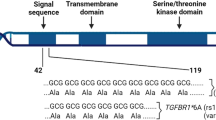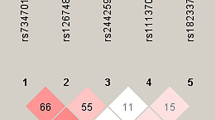Abstract
Activated Leukocyte Cell Adhesion Molecules (ALCAM, also called CD166, MEMD) are cell surface immunoglobulins that are considered to be prognostic markers for breast cancer. CD166/ALCAM has gained increasing attention because of its significant association with tumor progression and the metastatic spread of breast cancer. Two polymorphisms have been identified in the CD166/ALCAM gene: 5′UTR C/T (rs6437585) and 3′UTR A/G (rs11559013). We analyzed the genotypes of 1033 individuals with breast cancer, and 1116 controls; odds ratios (ORs) and 95% confidence intervals (CIs) were estimated using logistic regression. The effects and functions of polymorphisms were examined using luciferase gene expression assays and real-time PCR analyses. Our data demonstrated that individuals with the rs6437585 CT + TT genotype had an OR of 1.38 (95% CI, 1.11–1.72) for developing breast cancer, compared to those with the CC genotype. The T allele increased the risk of breast cancer in a dose-dependent manner (P trend < 0.001). However, there were no significant differences found between cases and controls at the rs11559013 A/G site. Additional experiments that we performed, which focused on reporter gene expression driven by CD166/ALCAM promoters, demonstrated that the presence of an rs6437585 T allele led to greater transcriptional activity than the rs6437585 C allele. This was consistent with the increased cancer risk that we observed in our case–control analysis.

Similar content being viewed by others
Abbreviations
- BMI:
-
Body mass index
- ALCAM:
-
Activated leukocyte cell adhesion molecule
- CI:
-
Confidence interval
- OR:
-
Odds ratio
- SNP:
-
Single nucleotide polymorphism
References
Feig SA, Hendrick RE (1997) Radiation risk from screening mammography of women aged 40–49 years. J Natl Cancer Inst Monogr 22(22):119–124
Chlebowski RT, Blackburn GL, Thomson CA, Nixon DW, Shapiro A, Hoy MK, Goodman MT, Giuliano AE, Karanja N, McAndrew P, Hudis C, Butler J, Merkel D, Kristal A, Caan B, Michaelson R, Vinciguerra V, Del Prete S, Winkler M, Hall R, Simon M, Winters BL, Elashoff RM (2006) Dietary fat reduction and breast cancer outcome: interim efficacy results from the women’s intervention nutrition study. J Natl Cancer Inst 98(24):1767–1776. doi:98/24/1767[pii]10.1093/jnci/djj494
Boffetta P, Hashibe M, La Vecchia C, Zatonski W, Rehm J (2006) The burden of cancer attributable to alcohol drinking. Int J Cancer 119(4):884–887. doi:10.1002/ijc.21903
Yager JD, Davidson NE (2006) Estrogen carcinogenesis in breast cancer. N Engl J Med 354(3):270–282. doi:354/3/270[pii]10.1056/NEJMra050776
Andrieu N, Clavel F, Auquier A, Le MG, Gairard B, Piana L, Bremond A, Lansac J, Flamant R, Renaud R (1993) Variations in the risk of breast cancer associated with a family history of breast cancer according to age at onset and reproductive factors. J Clin Epidemiol 46(9):973–980. doi:0895-4356(93)90164-V[pii]
van Kempen LC, Nelissen JM, Degen WG, Torensma R, Weidle UH, Bloemers HP, Figdor CG, Swart GW (2001) Molecular basis for the homophilic activated leukocyte cell adhesion molecule (alcam)–alcam interaction. J Biol Chem 276(28):25783–25790. doi:10.1074/jbc.M011272200M011272200[pii]
Swart GW (2002) Activated leukocyte cell adhesion molecule (cd166/alcam): developmental and mechanistic aspects of cell clustering and cell migration. Eur J Cell Biol 81(6):313–321
Patel DD, Wee SF, Whichard LP, Bowen MA, Pesando JM, Aruffo A, Haynes BF (1995) Identification and characterization of a 100-kd ligand for cd6 on human thymic epithelial cells. J Exp Med 181(4):1563–1568
Bowen MA, Patel DD, Li X, Modrell B, Malacko AR, Wang WC, Marquardt H, Neubauer M, Pesando JM, Francke U et al (1995) Cloning, mapping, and characterization of activated leukocyte-cell adhesion molecule (alcam), a cd6 ligand. J Exp Med 181(6):2213–2220
Stephan JP, Bald L, Roberts PE, Lee J, Gu Q, Mather JP (1999) Distribution and function of the adhesion molecule ben during rat development. Dev Biol 212(2):264–277. doi:10.1006/dbio.1999.9348S0012-1606(99)99348-X[pii]
Seshi B, Kumar S, Sellers D (2000) Human bone marrow stromal cell: coexpression of markers specific for multiple mesenchymal cell lineages. Blood Cells Mol Dis 26(3):234–246. doi:10.1006/bcmd.2000.0301S1079-9796(00)90301-2[pii]
Degen WG, van Kempen LC, Gijzen EG, van Groningen JJ, van Kooyk Y, Bloemers HP, Swart GW (1998) Memd, a new cell adhesion molecule in metastasizing human melanoma cell lines, is identical to alcam (activated leukocyte cell adhesion molecule). Am J Pathol 152(3):805–813
van Kempen LC, van den Oord JJ, van Muijen GN, Weidle UH, Bloemers HP, Swart GW (2000) Activated leukocyte cell adhesion molecule/cd166, a marker of tumor progression in primary malignant melanoma of the skin. Am J Pathol 156(3):769–774
Tomita K, van Bokhoven A, Jansen CF, Bussemakers MJ, Schalken JA (2000) Coordinate recruitment of e-cadherin and alcam to cell–cell contacts by alpha-catenin. Biochem Biophys Res Commun 267(3):870–874. doi:10.1006/bbrc.1999.2040S0006-291X(99)92040-5[pii]
Jiang WG, Puntis MC, Hallett MB (1994) Molecular and cellular basis of cancer invasion and metastasis: implications for treatment. Br J Surg 81(11):1576–1590
King JA, Ofori-Acquah SF, Stevens T, Al-Mehdi AB, Fodstad O, Jiang WG (2004) Activated leukocyte cell adhesion molecule in breast cancer: prognostic indicator. Breast Cancer Res 6(5):R478–R487. doi:10.1186/bcr815bcr815[pii]
Ihnen M, Muller V, Wirtz RM, Schroder C, Krenkel S, Witzel I, Lisboa BW, Janicke F, Milde-Langosch K (2008) Predictive impact of activated leukocyte cell adhesion molecule (alcam/cd166) in breast cancer. Breast Cancer Res Treat 112(3):419–427. doi:10.1007/s10549-007-9879-y
Aubele M, Werner M (1999) Heterogeneity in breast cancer and the problem of relevance of findings. Anal Cell Pathol 19(2):53–58
Golub TR (2001) Genome-wide views of cancer. N Engl J Med 344(8):601–602. doi:10.1056/NEJM200102223440809
Jiang L, Zhang C, Li Y, Yu X, Zheng J, Zou P, Bin X, Lu J, Zhou Y (2010) A non-synonymous polymorphism thr115met in the epcam gene is associated with an increased risk of breast cancer in chinese population. Breast Cancer Res Treat. doi:10.1007/s10549-010-1094-6
Jiang L, Liang J, Jiang M, Yu X, Zheng J, Liu H, Wu D, Zhou Y (2010) Functional polymorphisms in the nbs1 gene and acute lymphoblastic leukemia susceptibility in a chinese population. Eur J Haematol. doi:10.1111/j.1600-0609.2010.01562.x
Lehmann U, Kreipe H (2001) Real-time pcr analysis of DNA and rna extracted from formalin-fixed and paraffin-embedded biopsies. Methods 25(4):409–418. doi:10.1006/meth.2001.1263S1046-2023(01)91263-0[pii]
Kristiansen G, Pilarsky C, Wissmann C, Stephan C, Weissbach L, Loy V, Loening S, Dietel M, Rosenthal A (2003) Alcam/cd166 is up-regulated in low-grade prostate cancer and progressively lost in high-grade lesions. Prostate 54(1):34–43. doi:10.1002/pros.10161
Uhlenbrock K, Eberth A, Herbrand U, Daryab N, Stege P, Meier F, Friedl P, Collard JG, Ahmadian MR (2004) The racgef tiam1 inhibits migration and invasion of metastatic melanoma via a novel adhesive mechanism. J Cell Sci 117(Pt 20):4863–4871. doi:10.1242/jcs.01367jcs.01367[pii]
Swart GW, Lunter PC, Kilsdonk JW, Kempen LC (2005) Activated leukocyte cell adhesion molecule (alcam/cd166): signaling at the divide of melanoma cell clustering and cell migration? Cancer Metastasis Rev 24(2):223–236. doi:10.1007/s10555-005-1573-0
Weichert W, Knosel T, Bellach J, Dietel M, Kristiansen G (2004) Alcam/cd166 is overexpressed in colorectal carcinoma and correlates with shortened patient survival. J Clin Pathol 57(11):1160–1164. doi:57/11/1160[pii]10.1136/jcp.2004.016238
Verma A, Shukla NK, Deo SV, Gupta SD, Ralhan R (2005) Memd/alcam: a potential marker for tumor invasion and nodal metastasis in esophageal squamous cell carcinoma. Oncology 68(4–6):462–470. doi:OCL20050684_6462[pii]10.1159/000086989
Moll J, Sleeman J, Kondo K, Hekele A, Plug R, Sherman L, Ponta H, Herrlich P, Schmidt A, Zoller M et al (1994) Analysis of molecular functions of the tumor metastasis promoting surface molecule cd44v4-v7 using transgenic mice. Princess Takamatsu Symp 24:142–151
Schmidt DS, Klingbeil P, Schnolzer M, Zoller M (2004) Cd44 variant isoforms associate with tetraspanins and epcam. Exp Cell Res 297(2):329–347. doi:10.1016/j.yexcr.2004.02.023S0014482704001090[pii]
Wurfel J, Rosel M, Seiter S, Claas C, Herlevsen M, Weth R, Zoller M (1999) Metastasis-association of the rat ortholog of the human epithelial glycoprotein antigen egp314. Oncogene 18(14):2323–2334. doi:10.1038/sj.onc.1202542
Acknowledgments
This study was supported by a Young Scientists fund of the Third Affiliated Hospital to Nantong University (SYQNJJ10001), the Medical Technology Development Fund of the Hospital Administration Center in Wuxi (YGM1014), and Science Foundation of Health Bureau of Wuxi (XM1010).
Conflicts of interest statement
None declared.
Author information
Authors and Affiliations
Corresponding authors
Rights and permissions
About this article
Cite this article
Zhou, P., Du, LF., Lv, GQ. et al. Functional polymorphisms in CD166/ALCAM gene associated with increased risk for breast cancer in a Chinese population. Breast Cancer Res Treat 128, 527–534 (2011). https://doi.org/10.1007/s10549-011-1365-x
Received:
Accepted:
Published:
Issue Date:
DOI: https://doi.org/10.1007/s10549-011-1365-x




